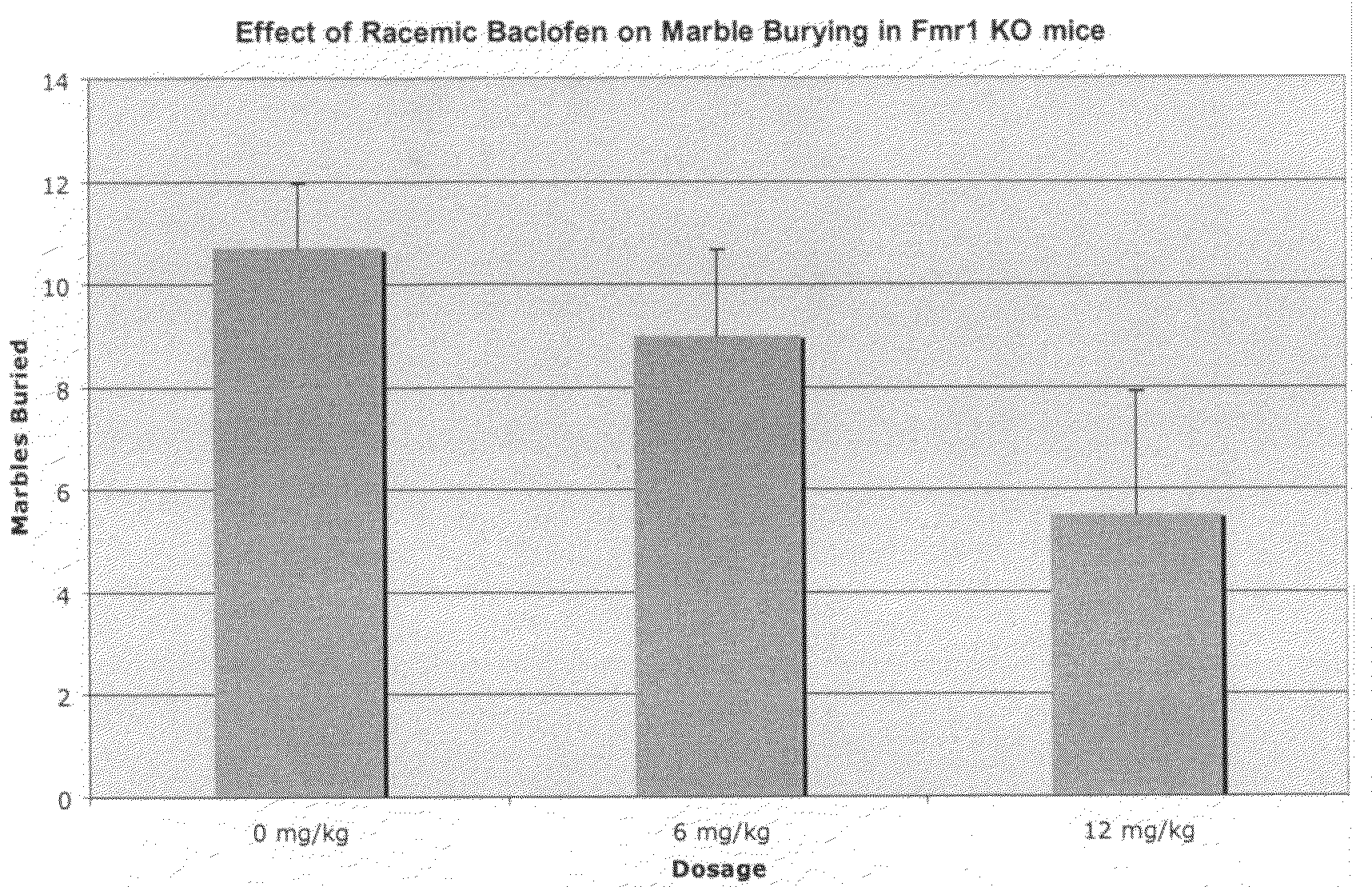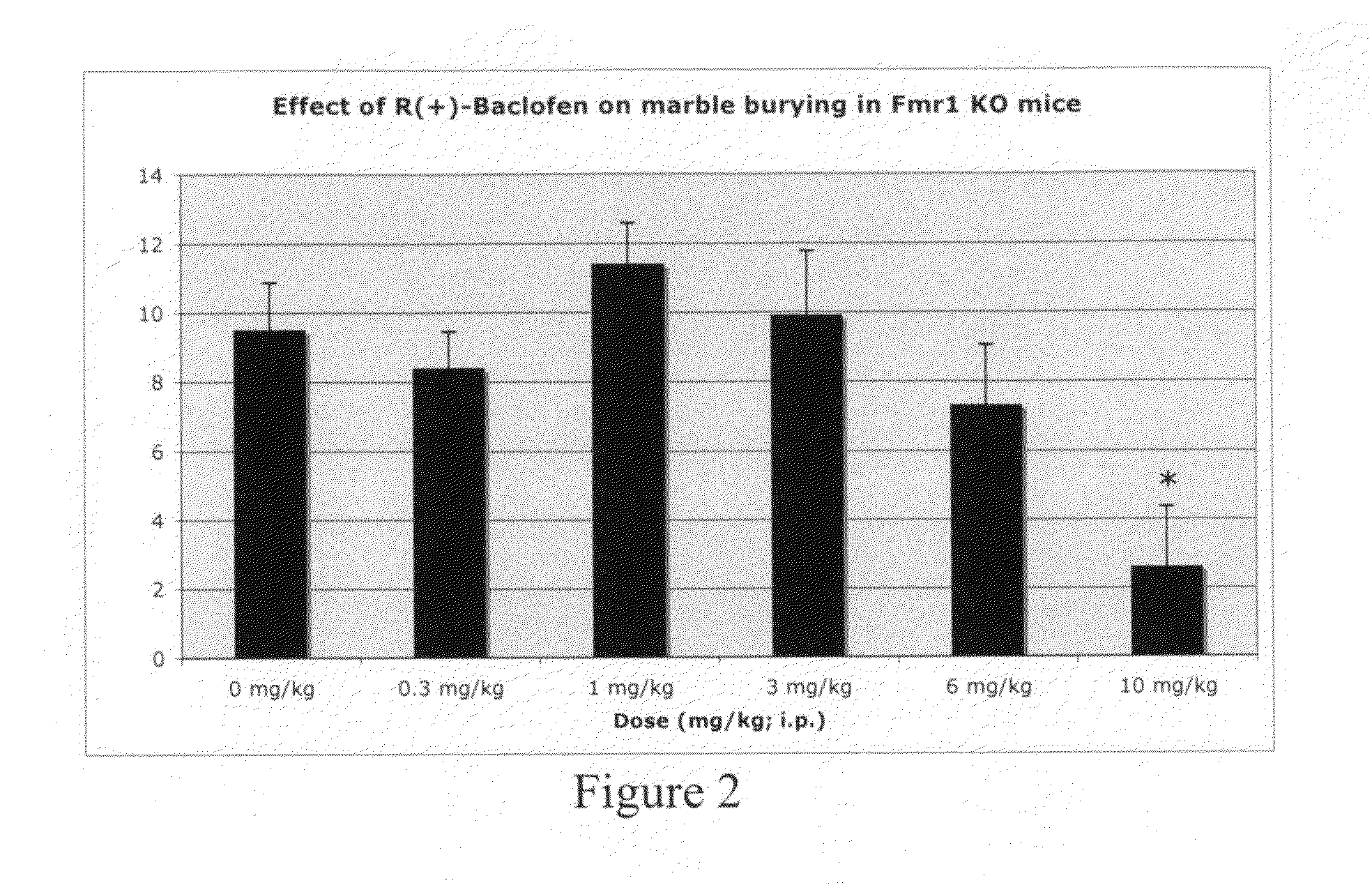Methods of treating mental retardation, down's syndrome, fragile X syndrome and autism
a mental retardation and autism technology, applied in the field of mental retardation treatment, can solve the problems of undesirable side effects and often ineffective regimens, and achieve the effects of improving symptoms, reducing anxiety and irritability, and increasing cognitive function, communication and/or social interaction
- Summary
- Abstract
- Description
- Claims
- Application Information
AI Technical Summary
Benefits of technology
Problems solved by technology
Method used
Image
Examples
example 1
Treatment of Autism with Baclofen
[0136]A 23 year old female with autism spectrum disorder (height 61″, weight 170 lbs) was hospitalized and being preparing for port-a-catheter placement to begin TPN for an undetermined period of time to allow total gut rest. Baclofen was prescribed 5 mg tid (three times daily) to improve bowel motility. Within about 24 hours abdominal pain appeared to be resolved and GI motility became functional, allowing oral feeding. Over the next several days and weeks improvements were noted in cognitive and behavioral domains that had been unchanged for over 10 years.
[0137]For example, improvements with social interaction as evidenced by
[0138]a. Increased interest and response to spoken language
[0139]b. Increased spontaneous attempts to interact
[0140]c. Increased joint attention and eye contact;
[0141]improvements in motor coordination as evidenced by
[0142]a. greatly improved oral motor
[0143]b. improved motor planning
[0144]c. improved gait;
[0145]improvements in...
example 2
Treatment of Autism with Baclofen
[0168]A 12 year old male with autism spectrum disorder (height=54″, weight=64 lbs) was treated with baclofen. Baclofen (about 5 mg bid) was initially administered with baclofen in an attempt to reduce gastroesophageal reflux symptoms. Over the next several days and weeks improvements were noted in several cognitive and behavioral domains such as increased interest and response to spoken language and attempts to communicate verbally. Dramatic improvements in mood and affect such as “looks comfortable, calm and happy” were also noted. Increased alertness, interest and motivation to work on cognitive / educational activities with school instructors were also noted. School personnel record behavior on a daily basis, are not informed regarding changes in drug treatment and did not know that baclofen had been prescribed for this subject. Daily scores were averaged over the five weeks after initiating baclofen therapy and compared to the average scores for th...
example 3
Treatment of Autism with Baclofen
[0179]A 9 year old male with autism spectrum disorder (height=46″, weight=47 lbs) was treated with baclofen. Baclofen (5 mg bid) was initiated in an attempt to reduce gastroesophageal reflux symptoms. Over the next several days and weeks improvements were noted in cognitive and behavioral domains, such as increased interest and response to spoken language and spontaneous attempts to communicate. Parents also noted an improvement in sleep patterns, mood and affect. Increased alertness, interest and motivation to work on cognitive / educational activities were noted by school personnel. School personnel record behavior on a daily basis, are not informed regarding changes in drug treatment and did not know that baclofen had been prescribed for this subject. Daily scores were averaged over the five weeks after initiating baclofen therapy and compared to the average scores for the five weeks immediately preceding initiation of baclofen therapy. Improvements...
PUM
| Property | Measurement | Unit |
|---|---|---|
| weight | aaaaa | aaaaa |
| mole percent | aaaaa | aaaaa |
| fragile | aaaaa | aaaaa |
Abstract
Description
Claims
Application Information
 Login to View More
Login to View More - R&D
- Intellectual Property
- Life Sciences
- Materials
- Tech Scout
- Unparalleled Data Quality
- Higher Quality Content
- 60% Fewer Hallucinations
Browse by: Latest US Patents, China's latest patents, Technical Efficacy Thesaurus, Application Domain, Technology Topic, Popular Technical Reports.
© 2025 PatSnap. All rights reserved.Legal|Privacy policy|Modern Slavery Act Transparency Statement|Sitemap|About US| Contact US: help@patsnap.com



